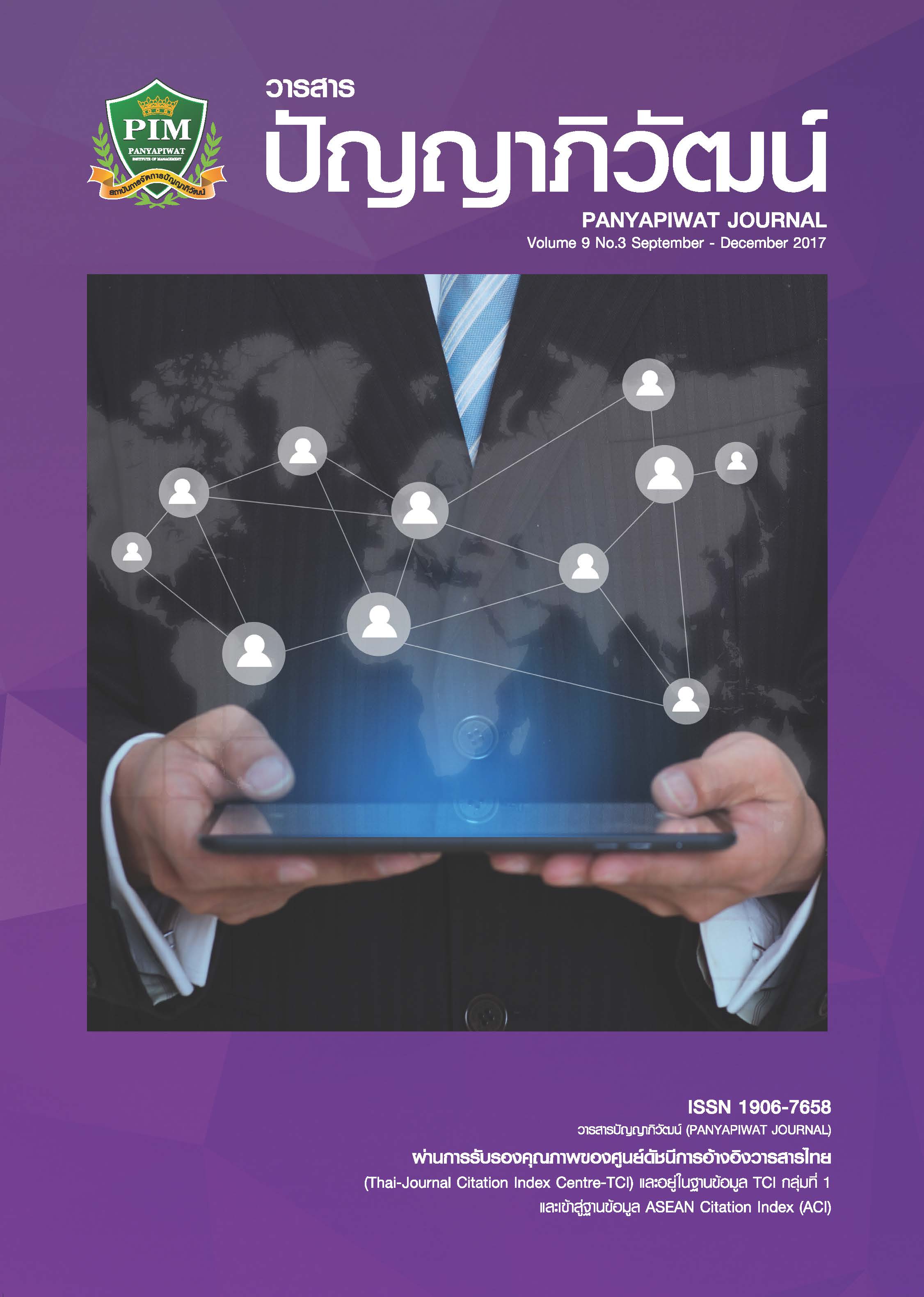การยอมรับเทคโนโลยีที่มีอิทธิพลต่อแนวโน้มความตั้งใจในการใช้บริการซื้อสินค้าผ่านช่องทางออนไลน์ของกลุ่มเบบี้บูมเมอร์ในกรุงเทพมหานคร
Main Article Content
บทคัดย่อ
การศึกษาวิจัยเรื่อง การยอมรับเทคโนโลยีที่มีอิทธิพลต่อแนวโน้มความตั้งใจในการใช้บริการซื้อสินค้าผ่านช่องทางออนไลน์ของกลุ่มเบบี้บูมเมอร์ในกรุงเทพมหานคร มีวัถตุประสงค์เพื่อศึกษาการยอมรับเทคโนโลยีที่มีอิทธิพลต่อแนวโน้มความตั้งใจในการใช้บริการซื้อสินค้าผ่านช่องทางออนไลน์ของกลุ่มเบบี้บูมเมอร์ในกรุงเทพมหานคร เก็บรวบรวมข้อมูลจากกลุ่มเบบี้บูมเมอร์ที่พักอาศัยอยู่ในกรุงเทพมหานคร จำนวน 400 คน สถิติที่ใช้ในการวิเคราะห์เก็บข้อมูล ได้แก่ ค่าร้อยละ ค่าเฉลี่ย ส่วนเบี่ยงเบนมาตรฐาน และสถิติที่ใช้ทดสอบสมมติฐานคือ การวิเคราะห์การถดถอยเชิงพหุ
ผลการวิจัยพบว่า กลุ่มตัวอย่างส่วนใหญ่เป็นเพศหญิง มีอายุ 53-59 ปี ส่วนใหญ่สำเร็จการศึกษาระดับปริญญาตรี มีรายได้ประมาณ 30,001-40,000 บาท มากที่สุด โดยอาชีพปัจจุบันหรือก่อนเกษียณอายุพบว่า กลุ่มตัวอย่างส่วนใหญ่มีอาชีพพนักงานบริษัทเอกชน สำหรับภาพรวมของความคิดเห็นของผู้ตอบแบบสอบถามเกี่ยวกับการยอมรับเทคโนโลยีที่มีอิทธิพลต่อแนวโน้มความตั้งใจในการใช้บริการซื้อสินค้าผ่านช่องทางออนไลน์อยู่ในระดับปานกลาง โดยพบว่า การยอมรับเทคโนโลยีที่มีอิทธิพลต่อแนวโน้มความตั้งใจในการใช้บริการซื้อสินค้าผ่านช่องทางออนไลน์ที่มีระดับความคิดเห็นมากที่สุดคือ การรับรู้ประโยชน์ รองลงมาคือ การรับรู้ความเสี่ยง อิทธิพลทางสังคม ทัศนคติที่มีต่อการใช้ และการรับรู้ความง่าย ตามลำดับ และผลการทดสอบสมมติฐานพบว่า การยอมรับเทคโนโลยี ด้านการรับรู้ความง่าย ด้านอิทธิพลทางสังคม ด้านการรับรู้ความเสี่ยง และด้านทัศนคติที่มีต่อการใช้ มีผลต่อแนวโน้มความตั้งใจในการใช้บริการซื้อสินค้าผ่านช่องทางออนไลน์ของกลุ่มเบบี้บูมเมอร์ในเขตกรุงเทพมหานคร ในขณะที่การรับรู้ประโยชน์ไม่มีผลต่อแนวโน้มความตั้งใจในการใช้บริการซื้อสินค้าผ่านช่องทางออนไลน์ของกลุ่มเบบี้บูมเมอร์ในเขตกรุงเทพมหานคร
The purposes of the study on technology acceptance affecting intention tendency on online shopping of Baby Boomers in Bangkok metropolitan as for study technology acceptance affecting intention tendency on online shopping of Baby Boomers in Bangkok metropolitan. The data collection is done through questionnaires by 400 baby boomers living in Bangkok metropolitan. The statistics used for data analysis include percentage, mean, standard deviation. The statistics used for hypothesis testing includes multiple linear regression.
The findings include the samples are mostly females, aged between 53-59 years old, most completed bachelor degree, with income 30,0001-40,000 Baht. Current and pre-retirement occupations are mostly private company employees. The overall opinions of the questionnaire respondents on technology acceptance affecting intention tendency on online shopping are in moderate level. The highest opinion dimensions are perceived usefulness, perceived risk, social influence, attitude toward using and perceived ease of use, respectively. According to the hypothesis, it shows that technology acceptance in perceived ease of use, social influence, perceived risk and attitude toward using have effects on intention tendency on online shopping of Baby Boomers in Bangkok Metropolitan while perceived usefulness has no effects.
Article Details
“ข้าพเจ้าและผู้เขียนร่วม (ถ้ามี) ขอรับรองว่า บทความที่เสนอมานี้ยังไม่เคยได้รับการตีพิมพ์และไม่ได้อยู่ระหว่างกระบวนการพิจารณาลงตีพิมพ์ในวารสารหรือแหล่งเผยแพร่อื่นใด ข้าพเจ้าและผู้เขียนร่วมยอมรับหลักเกณฑ์การพิจารณาต้นฉบับ ทั้งยินยอมให้กองบรรณาธิการมีสิทธิ์พิจารณาและตรวจแก้ต้นฉบับได้ตามที่เห็นสมควร พร้อมนี้ขอมอบลิขสิทธิ์บทความที่ได้รับการตีพิมพ์ให้แก่สถาบันการจัดการปัญญาภิวัฒน์หากมีการฟ้องร้องเรื่องการละเมิดลิขสิทธิ์เกี่ยวกับภาพ กราฟ ข้อความส่วนใดส่วนหนึ่งและ/หรือข้อคิดเห็นที่ปรากฏในบทความข้าพเจ้าและผู้เขียนร่วมยินยอมรับผิดชอบแต่เพียงฝ่ายเดียว”
เอกสารอ้างอิง
Agarwal, R. & Prasad, J. (1999). Are individual differences germane to the acceptance of new information technologies? Decision sciences, 30(2), 361-391.
Ajzen, I. & Fishbein, M. (1975). Belief, attitude, intention and behavior: An introduction to theory and research. MA: Addison-Wesley.
_______. (1977). Belief, attitude, intention and behavior: An introduction to theory and research. Philosophy and Rhetoric, 10(2), 130-132.
Ben-Ur, J. & Winfield, C. (2002). Perceived Risk in the E-commerce Environment. Retrieved November 5, 2016, from https://www.sbaer.uca.edu/Research/2000/SWMA/00swma15.htm
Cronbach, L. J. (1951). Coefficient alpha and the internal structure of tests. Psychometrika, 16(3), 297-334.
Davis, F. D. (1989). Perceived usefulness, perceived ease of use, and user acceptance of information technology. MIS quarterly, 13(3), 319-340.
Davis, F. D., Bagozzi, R. P. & Warshaw, P. R. (1989). User acceptance of computer technology: a comparison of two theoretical models. Management science, 35(8), 982-1003.
DESA, U. (2015). United Nations Department of Economic and Social Affairs 2015: World Urbanization Prospects. Retrieved November 5, 2016, from https://www.un.org/en/development/desa/population/
Eagly, A. H. & Chaiken, S. (1993). The psychology of attitudes. Harcourt Brace Jovanovich College Publishers.
Electronic Transactions Development Agency (Public Organization). (2016). Thailand internet user profile 2016. Retrieved March 5, 2017, from https://www.etda.or.th/publishing-detail/thailand-internet-user-profile-2016-th.html [in Thai]
Forsythe, S. M. & Shi, B. (2003). Consumer patronage and risk perceptions in Internet shopping. Journal of Business research, 56(11), 867-875.
Gupta, A., Su, B. C. & Walter, Z. (2004). Risk profile and consumer shopping behavior in electronic and traditional channels. Decision Support Systems, 38(3), 347-367.
Ha, S. & Stoel, L. (2009). Consumer e-shopping acceptance: Antecedents in a technology acceptance model. Journal of Business Research, 62(5), 565-571.
Jackson, C. M., Chow, S. & Leitch, R. A. (1997). Toward an understanding of the behavioral intention to use an information system. Decision sciences, 28(2), 357-389.
Jarvenpaa, S. L. & Todd, P. A. (1996). Consumer reactions to electronic shopping on the World Wide Web. International Journal of electronic commerce, 1(2), 59-88.
_________. (1997). Is there a future for retailing on the Internet. Electronic marketing and the consumer, 1(12), 139-154.
Kelman, H. C. (1958). Compliance, identification, and internalization three processes of attitude change. Journal of conflict resolution, 2(1), 51-60.
Kuo, H. M., Chen, C. W. & Hsu, C. H. (2012). A study of a B2C supporting interface design system for the elderly. Human Factors and Ergonomics in Manufacturing & Service Industries, 22(6), 528-540.
Lignell, A. (2014). Older Consumers’ Adoption of Online Shopping. Retrieved March 25, 2016, from https://www.doria.fi/bitstream/handle/10024/95639/older-consumers-adoption-of-online-shopping-lignell-annamari.pdf?sequence=3&isAllowed=y
Malhotra, Y. & Galletta, D. F. (1999). Extending the technology acceptance model to account for social influence: Theoretical bases and empirical validation. In Systems sciences, HICSS-32.Proceedings of the 32nd annual Hawaii international conference. IEEE.
Ministry of Interior, Official Statistics Registration Systems. (2015). Report on Population Characteristics Survey. Retrieved March 5, 2016, from https://stat.dopa.go.th/stat/statnew/upstat_age.php [in Thai]
Ministry of Social Development and Human Security. (2014). Thailand Population Ageing: Now and Future. Retrieved March 3, 2016, from https://www.m-society.go.th/article_attach/13225/17347.pdf [in Thai]
National Statistical Office. (2016). The 2016 Household Survey on the Use of Information and Communication Technology. Retrieved March 2, 2016, from https://service.nso.go.th/nso/web/survey/surtec5-1-3.html [in Thai]
Pan, S. & Jordan-Marsh, M. (2010). Internet use intention and adoption among Chinese older adults: From the expanded technology acceptance model perspective. Computers in human behavior, 26(5), 1111-1119.
Reisenwitz, T. & Iyer, R. (2007). A comparison of younger and older baby boomers: investigating the viability of cohort segmentation. Journal of Consumer Marketing, 24(4), 202-213.
Schiffman, L. G. & Kanuk, L. L. (2007). Consumer Behavior (9th ed.). Upper Saddle River: Pearson Education.
________. (2009). Consumer Behavior (10th ed.). Upper Saddle River: Pearson Education.
Strategy and Evaluation Department, Bangkok Metropolitan Administration. (2015). Bangkok Metropolitan. Retrieved July 5, 2017, from https://203.155.220.230/m.info/bma_k/knw5.html [in Thai]
Thom, G. (2000). Online shop lags. Delivery doubt slows growth. Melbourne: Herald Sun.
Venkatesh, V. (1999). Creation of favorable user perceptions: exploring the role of intrinsic motivation. MIS quarterly, 23(2), 239-260.
Venkatesh, V., Morris, M. G., Davis, G. B. & Davis, F. D. (2003). User acceptance of information technology: Toward a unified view. MIS quarterly, 27(3), 425-478.
Verhoef, P. C. & Langerak, F. (2001). Possible determinants of consumers’ adoption of electronic grocery shopping in the Netherlands. Journal of Retailing and Consumer Services, 8(5), 275-285.
Vijayasarathy, L. R. (2002). Product characteristics and Internet shopping intentions. Internet Research, 12(5), 411-426.
Vijayasarathy, L. R. (2004). Predicting consumer intentions to use on-line shopping: the case for an augmented technology acceptance model. Information & management, 41(6), 747-762.
Yang, K., & Jolly, L. D. (2008). Age cohort analysis in adoption of mobile data services: gen Xers versus baby boomers. Journal of Consumer Marketing, 25(5), 272-280.


